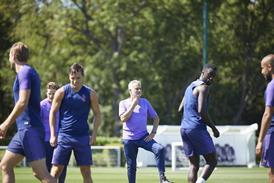With demand at an all-time high, an estimated 300,000 sq ft of purpose-built stages came on stream this year, with capacity set to rise further in 2017.
The UK’s world-class craft skills base and facilities have long made it attractive to overseas producers, but the collapse of the pound post-referendum poured more fuel on an already overheated sector.
“To put it cynically, the exchange rate since Brexit has done us a favour and has, if anything, intensified the volume of enquiries, particularly from the US,” says Adrian Wootton, chief executive of Film London and the British Film Commission, both of which continue to “aggressively” market UK studios.
“We’ve done really well to manage capacity, but we do want more,” he adds. “I don’t think we’re tapped out in terms of demand or potential for more infrastructure.”
The unprecedented boom in studio occupancy continues to be driven by TV tax breaks, with high-end drama soaking up capacity on the nation’s sound stages.
Among those in production this year were series three of E!’s The Royals (3 Mills Studios), Sony Pictures’ The Halcyon (West London Film Studios), ITV’s Victoria (Yorkshire’s Church Fenton Studios), BBC1’s Poldark and Starz’s The White Princess (both Bristol’s The Bottle Yard). Amazon’s The Collection was one of the first shows to land at Pinewood Wales and Netflix’s The Crown was resident at Elstree.
“The Crown is shot as a feature, has similar budgets and uses the 15,000 sq ft George Lucas Stage, backlot and other, smaller stages,” says Elstree managing director Roger Morris, who had to turn away films such as Paddington 2 to accommodate it.
With demand showing no signs of abating, Elstree owner Hertsmere Borough Council has tabled a proposal to build a new 13,000 sq ft studio by 2018, on top of existing plans to add a 21,000 sq ft stage.
The sector seemingly can’t build space quickly enough to sate demand.
By Broadcast’s estimates, 300,000 sq ft of purpose-built stages came on stream this year: three sound stages totalling 70,000 sq ft, at Warner Bros Leavesden; 170,000 sq ft across five stages at Pinewood’s Buckinghamshire HQ; and the 66,000 sq ft North Foreshore Film Studios, a new £20m development by the Belfast Harbour Commission.
With Game Of Thrones sucking up two new 21,000 sq ft sound stages at Belfast’s Titanic Studios, Northern
Ireland needed fresh bespoke space to keep pace with the rise in TV drama. There are already plans to build a further 42,000 sq ft.
“We’re investing more in training and bringing more people into the region to service anticipated new productions,” says NI Screen head of production Andrew Reid, who is anticipating the departure of GoT by April 2018, once production wraps on the eighth and final series.
Capacity is set to rise further by the end of 2017 when Elstree unwraps its new stage, TVC returns with three studios, and Manchester’s The Space Project doubles in size with Outer Space, which will include a 30,000 sq ft stage. It follows the first full trading year of the drama hub, which has housed productions such as Cold Feet and Houdini And Doyle.
A little further down the track is a proposed £30m, 110,000 sq ft complex in Liverpool, the city that attracts more film and TV location shoots than any outside London.
Construction is earmarked to begin in the new year.
In Birmingham, which welcomed Steven Spielberg’s location shoot for Warner Bros’ movie Ready Player One in September, the city council and the
NEC Group are considering whether to build a TV and film studio complex.
Meanwhile, unable to expand its current site but wanting to cash in on demand, the owners of Twickenham Studios are investigating management of external studios, either in the UK or abroad, under the Twickenham brand.
Like Pinewood, they’re keen to invest in TV and film production (indie feature Finding Your Feet was the first).
The X Factor final on 11 December will bring down the curtain on Wembley’s Fountain Studios, following January’s sale by parent Avesco to property developer Quintain for £16m.
Its laser-levelled floors will be demolished for housing, leaving shows like Britain’s Got Talent looking for a new home and calling time on a site that has been used as a film and TV space since the 1930s. The second iconic studios to go under the hammer to a real estate firm in 2016 enjoyed a different outcome.
The Pinewood board raised the possibility of a sale in February, announcing a strategic review of its structure and ownership. The motivation was a need to access quick capital for expansion, which its existing owner ship base appeared to be stifling.
The £320m deal struck in July with Venus Grafton, a subsidiary of the French PW Real Estate Fund, was immediately hailed by chief executive Ivan Dunleavy as securing the studio group’s long-term future.
Full steam ahead

Pinewood director of strategy Andrew Smith declared it was full steam ahead for phase two of the £200m Pinewood development plan, which will build another five stages spanning 170,000 sq ft.
With the Buckinghamshire site busy with Star Wars Episode IX, the group launched a TV investment fund under creative director Helen Gregory (The Catch) and co-production director Christian Wikander (The Bridge), beginning with a Sony/AXN development deal.
Movie producers and their stars – and, by extension, the marquee names driving high-end TV – prefer to be within shooting distance of London.
That is one factor driving the proposal to repurpose a 17-acre brownfield site in Dagenham into a film and TV studio second only in size to Pinewood in the UK.
“We are getting repeat requests from productions wanting to be within the M25,” says Wootton. “Property in London is at a premium and this site is one of the last big development opportunities for media in the capital.”
The London Local Enterprise Partnership, Barking and Dagenham Council and Film London are all optimistic that a business case can be made for a public and private financed facility, which they estimate could bring in more than £100m in UK spend. Pending the results of a feasibility study due in late spring 2017, doors could open in three years.
The move would offset the long-term uncertainty around another London site: 3 Mills Studios.
While studio head Tom Avison reports the busiest time yet for the Bromley-by-Bow base and solid bookings, operator London Legacy Development Corporation is mulling whether to reassign the 80,000 sq ft site, possibly as storage for museums that are due to open up in the Olympic Park.
“The film industry has historically been based in west London, yet the natural evolution of London is to the east,” says Avison. “We welcome a new studio, since it will entice more crew to be based near here.”
THE WAIT CONTINUES IN SCOTLAND
The Scottish government had been expected to rule on the £140m, 130,000 sq ft Edinburgh studio development in August but, at the time of writing, there had been no decision. However, it did approve a 30,000 sq ft extension at Wardpark, the home of Outlander.
Two 50 ft high sound stages will bring space there to 78,000 sq ft, but the only other purpose-built unit in the nation is a 5,000 sq ft stage on Stornaway.
RECORD SPEND
While Scotland attracted a record £45.8m shooting spend in 2014 (the latest year for which fi gures are available), much of this was for the country as a backdrop. Across Scotland, annual production spend was up by around 40% in 2016.
“The need for more dedicated studio space is pressing,” says British Film Commission chair Iain Smith. “The Scottish government and Creative Scotland have been very cautious, despite attempts by many of us to persuade them of the opportunity they are in danger of missing.
“Ten years ago, Scotland had the biggest amount of media activity outside the south-east. Now it has lost market share to Cardiff, Bristol, Northern Ireland, Manchester and Leeds at a time of greatest opportunity.”





























No comments yet